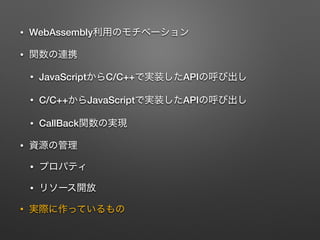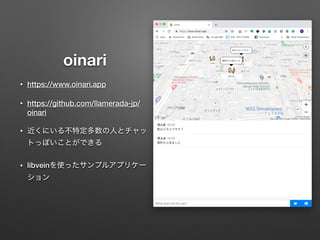颁/颁++と奥别产础蝉蝉别尘产濒测を利用したライブラリ开発
- 1. C/C++ WebAssembly / @llamerada_jp 2019/04/19 Emscripten & WebAssembly night !! #7
- 2. ? ? ; SE ? , Java, Cloud, VMWare ? ; ? C/C++, go, WebAssembly, WebRTC, WebSocket ? PROCESS WARP ? twitter ; @llamerada_jp ? facebook ; https://www.facebook.com/ito.yuuji ? github ; https://github.com/llamerada-jp
- 3. ? WebAssembly ? ? JavaScript C/C++ API ? C/C++ JavaScript API ? CallBack ? ? ? ?
- 5. ? WebAssembly ? ? JavaScript C/C++ API ? C/C++ JavaScript API ? CallBack ? ? ? ?
- 6. C/C++( ) WebAssembly(emscripten) web export ? ?
- 7. ? WebAssembly ? ? JavaScript C/C++ API ? C/C++ JavaScript API ? CallBack ? ? ? ?
- 8. C/C++ ? C++ name mangling extern "C" export ? EMSCRIPTEN_KEEPALIVE ? ? -s 'EXPORTED_FUNCTIONS=["_<C >", …]'? ( ) extern "C" { EMSCRIPTEN_KEEPALIVE int c_func(int p_int, void* p_ptr); }
- 9. Build ? $ emcc … -s 'EXTRA_EXPORTED_RUNTIME_METHODS=["ccall", “cwrap"]'
- 10. JavaScript ? ccall, cwrap ; emscripten ? (.wasm WebAssembly.Instance.exports) let r = ccall( 'c_func', // C 'number', // number(pointer ), array, string, boolean ['number', 'number'], // [< >, < >] // ); let f = cwrap('c_func', 'number', ['number', 'number']); f(< >, < >);
- 11. ? WebAssembly ? ? JavaScript C/C++ API ? C/C++ JavaScript API ? CallBack ? ? ? ?
- 12. JavaScript ? C/C++ export JavaScript API <api > mergeInto(LibraryManager.library, { js_func: function(p1, p2) { // … }, … });
- 13. Build ? $ emcc … --js-library <api >
- 14. C/C++ ? C/C++ extern "C" { extern void js_func(int p1, void* p2); } ? js_func(100, &val);
- 15. ? WebAssembly ? ? JavaScript C/C++ API ? C/C++ JavaScript API ? CallBack ? ? ? ?
- 16. JavaScript ? JavaScript C ? addFunction ; JavaScript emscripten ? ccall C/C++ ? C/C++ ? let f_ptr = addFunction( js_func.bind(this), // bind 'vi' // (1 ), (2 ) // v:void, i:int32, j:int64, f:float, d:double );
- 17. Build ? $ emcc … -s 'RESERVED_FUNCTION_POINTERS=< >' ? ? JavaScript on Callback
- 18. ? Promise (※ ) connect(url, token) { const promise = new Promise((resolve, reject) => { // resolve/reject let onSuccess = addFunction((veinPtr) => { resolve(); }, 'vi'); let onFailure = addFunction((veinPtr) => { reject(); }, 'vi'); let [urlPtr] = allocPtrString(url); let [tokenPtr] = allocPtrString(token); // C/C++ Callback ccall('js_connect', 'null', ['number', 'number', 'number', 'number'], [this._veinPtr, urlPtr, tokenPtr, onSuccess, onFailure]); freePtr(url); freePtr(token); }); return promise; }
- 19. ? WebAssembly ? ? JavaScript C/C++ API ? C/C++ JavaScript API ? CallBack ? ? ? ?
- 20. C++ class ? ID JavaScript ? JavaScript C++ ID ? C ID C++ ('A`)
- 21. get/set <C/C++> extern "C" { EMSCRIPTEN_KEEPALIVE int64_t get_int(PTR_T value_ptr); EMSCRIPTEN_KEEPALIVE void set_int(PTR_T value_ptr, int64_t v); } <JavaScript> get() { return ccall('get_int', 'number', ['number'], [this._valuePtr]); } set(v) { ccall('set_int', 'void', ['number', 'number'], [this._valuePtr, v]); }
- 22. ? get/set ? ? ? ? ( ) ? Module.HEAPU8 ? ? JavaScript get/set
- 23. ? WebAssembly ? ? JavaScript C/C++ API ? C/C++ JavaScript API ? CallBack ? ? ? ?
- 24. ? , ? new, delete ? alloc, free ? , ? open, close
- 25. ? JavaScript ? WebAssembly JavaScript GC (2019/04 ) ? ? JavaScript API
- 26. connect(url, token) { const promise = new Promise((resolve, reject) => { let onSuccess = addFunction((veinPtr) => { resolve(); }, 'vi'); let onFailure = addFunction((veinPtr) => { reject(); }, 'vi'); // JavaScript C/C++ let [urlPtr] = allocPtrString(url); let [tokenPtr] = allocPtrString(token); // ccall('js_connect', 'null', ['number', 'number', 'number', 'number'], // !C/C++ [this._veinPtr, urlPtr, tokenPtr, onSuccess, onFailure]); // freePtr(url); freePtr(token); }); return promise; }
- 27. disconnect() { // if (this._timerInvoke) { clearTimeout(this._timerInvoke); this._timerInvoke = false; } // C++ ccall('js_disconnect', 'null', ['number'], [this._veinPtr]); // JS delete this._instanceCache; }
- 28. ? WebAssembly ? ? JavaScript C/C++ API ? C/C++ JavaScript API ? CallBack ? ? ? ?
- 29. libvein ? ? KVS, 2 PubSub ? C/C++, Python, web ( )
- 31. Seed/Server (WebRTC ) Application API Application API Application API Node ( ) Application API Node Node Node Routing KVS, 2 PubSub WebSocket WebRTC




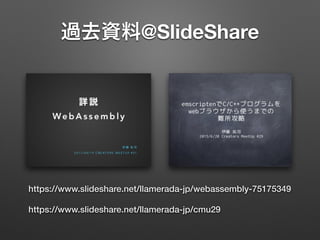
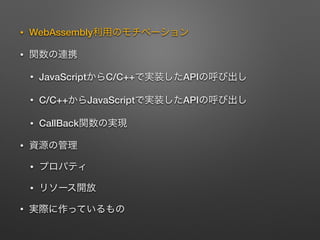
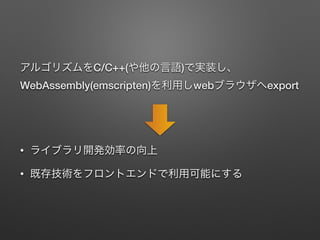
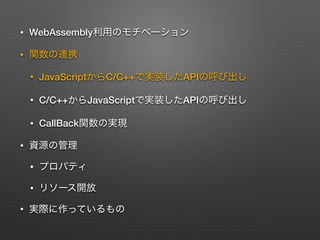
![C/C++
? C++ name mangling extern "C" export
? EMSCRIPTEN_KEEPALIVE ?
?
-s 'EXPORTED_FUNCTIONS=["_<C >", …]'?
( )
extern "C" {
EMSCRIPTEN_KEEPALIVE int c_func(int p_int, void* p_ptr);
}](https://image.slidesharecdn.com/ew-night07-190419101628/85/C-C-WebAssembly-8-320.jpg)
![Build
?
$ emcc …
-s 'EXTRA_EXPORTED_RUNTIME_METHODS=["ccall", “cwrap"]'](https://image.slidesharecdn.com/ew-night07-190419101628/85/C-C-WebAssembly-9-320.jpg)
![JavaScript
? ccall, cwrap ; emscripten ?
(.wasm WebAssembly.Instance.exports)
let r = ccall(
'c_func', // C
'number', // number(pointer ), array, string, boolean
['number', 'number'], //
[< >, < >] //
);
let f = cwrap('c_func', 'number', ['number', 'number']);
f(< >, < >);](https://image.slidesharecdn.com/ew-night07-190419101628/85/C-C-WebAssembly-10-320.jpg)
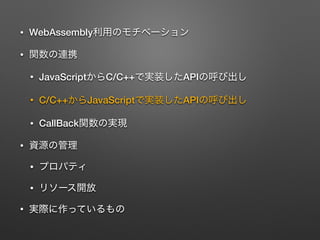
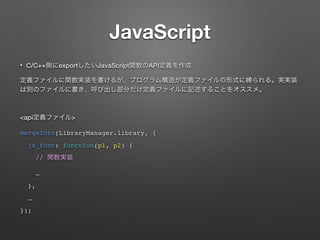
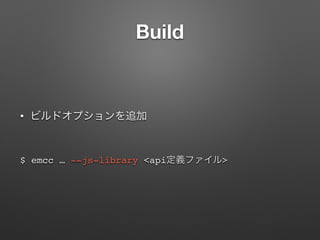

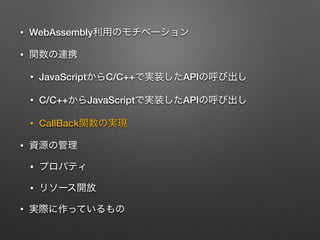
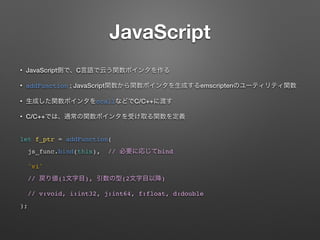

![? Promise (※ )
connect(url, token) {
const promise = new Promise((resolve, reject) => {
// resolve/reject
let onSuccess = addFunction((veinPtr) => { resolve(); }, 'vi');
let onFailure = addFunction((veinPtr) => { reject(); }, 'vi');
let [urlPtr] = allocPtrString(url);
let [tokenPtr] = allocPtrString(token);
// C/C++ Callback
ccall('js_connect', 'null',
['number', 'number', 'number', 'number'],
[this._veinPtr, urlPtr, tokenPtr, onSuccess, onFailure]);
freePtr(url);
freePtr(token);
});
return promise;
}](https://image.slidesharecdn.com/ew-night07-190419101628/85/C-C-WebAssembly-18-320.jpg)


![get/set
<C/C++>
extern "C" {
EMSCRIPTEN_KEEPALIVE int64_t get_int(PTR_T value_ptr);
EMSCRIPTEN_KEEPALIVE void set_int(PTR_T value_ptr, int64_t v);
}
<JavaScript>
get() {
return ccall('get_int', 'number', ['number'], [this._valuePtr]);
}
set(v) {
ccall('set_int', 'void', ['number', 'number'], [this._valuePtr, v]);
}](https://image.slidesharecdn.com/ew-night07-190419101628/85/C-C-WebAssembly-21-320.jpg)
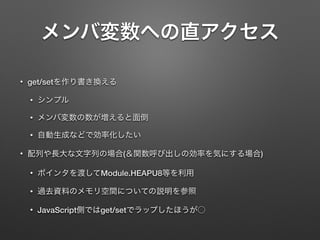
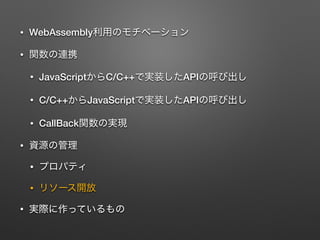
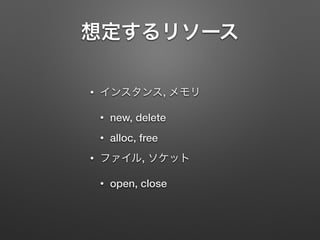
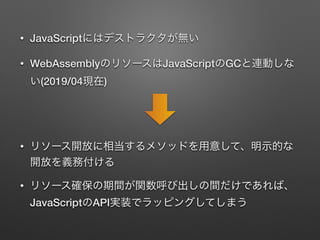
![connect(url, token) {
const promise = new Promise((resolve, reject) => {
let onSuccess = addFunction((veinPtr) => { resolve(); }, 'vi');
let onFailure = addFunction((veinPtr) => { reject(); }, 'vi');
// JavaScript C/C++
let [urlPtr] = allocPtrString(url);
let [tokenPtr] = allocPtrString(token);
//
ccall('js_connect', 'null',
['number', 'number', 'number', 'number'],
// !C/C++
[this._veinPtr, urlPtr, tokenPtr, onSuccess, onFailure]);
//
freePtr(url);
freePtr(token);
});
return promise;
}](https://image.slidesharecdn.com/ew-night07-190419101628/85/C-C-WebAssembly-26-320.jpg)
![disconnect() {
//
if (this._timerInvoke) {
clearTimeout(this._timerInvoke);
this._timerInvoke = false;
}
// C++
ccall('js_disconnect', 'null', ['number'], [this._veinPtr]);
// JS
delete this._instanceCache;
}](https://image.slidesharecdn.com/ew-night07-190419101628/85/C-C-WebAssembly-27-320.jpg)
